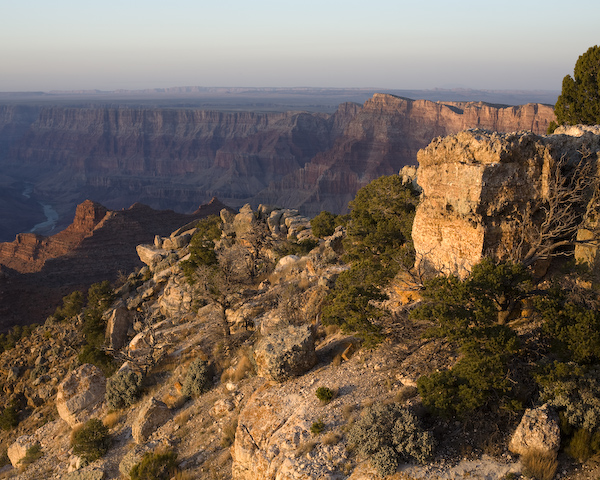Using Light from the Setting Sun
Earlier this year I submitted this image to a local exhibition in the “Sunset” category, and it got recategorized by the exhibition director into the “Landscape” division. I suspect that this director had a narrower definition in mind when he created the “Sunset” category — perhaps requiring that the setting sun actually be in the photograph. I did capture images with the sun in it, but this image, taken in some of the last rays of the day, was far more interesting to me. Rather than concentrating on what the sun was looking like, I was paying more attention to what the sun was doing to the canyon walls and rocks during its circadian swan song. The setting sun created a beautiful warm light and waning glow on the surrounding vista.
My process was to get to this location about an hour before sunset. I had scouted out this location during the afternoon and felt strongly that this is where I wanted to be at sunset. At key points along the south rim of the Grand Canyon, photographers have to stake out their spot well in advance of the main event. It was a cold and very windy day. I durst not leave my tripod unattended for fear that a gust of wind would knock it over. So, I stood there, enjoying the view, studying the features, and imagining what things would look like in another 5 minutes, 10 minutes, half an hour, etc.
Actually, I did more than just stand there shivering and thinking — I was snapping images. As I am fond of saying about digital photography, “the film is cheap”, so there was no marginal cost to take a few extra frames. I’m glad I did. Later, when I reviewed my images in a then-beta version of Adobe Lightroom, I watched a crude time-lapse movie of shadows growing longer and climbing up the canyon walls. The image here was not at the end of the sequence I shot. I selected this one because I liked the way the penultimate rays of sunlight capped the tops of the formations to the left and distant right of the frame; that effect was lost in subsequent frames.
I have not done much by way of sunset photography, but my few successful experiences have produced some guidelines that I find helpful:
-
1.Know when the sun will set.
-
-
Knowing the time of sunset will give you an idea as to when you should be in position at your intended location — at least half an hour before will give you a chance to set up your equipment and be ready. You may need to be there much earlier if you are in a popular (crowded) place.
-
-
2.Know where the sun will set.
-
-
For anywhere other than along the equator, this direction will change from day to day. Knowing where the sun will set will give you a clue as to what will be illuminated and how it will look; I try to find a spot that has interesting features to the east, as these will be illuminated by the low-angle rays at sunset.
-
-
3.Use a tripod and compose for the features that will be in the frame.
-
-
Sometimes the colors or the clouds in the sky will be the most remarkable part of the sunset — that’s hard to predict — but even a less-than-spectacular sky can contribute to a fine photograph if you’ve composed well with the other-than-sky features of the frame.
-
-
4.Consider aiming your camera in some direction other than west.
-
-
The sun will be somewhere in the west, but the sun may not be the most interesting subject for your photography; features to the north, east, or south may be particularly enhanced by the warm light, angled rays, and long shadows.
-
-
5.Take lots of images before, during, and after the setting of the sun.
-
-
The few moments when the sun is sinking out of view are not the only (and sometimes not even the best) for a fine photograph to be made; shooting through the appetizer, main course, and dessert will give you a much more satisfying meal, and much more to choose from later; you may find (as I did), that the best image happened outside of the setting moments.

Tip of the Week
2007.07.23

